火星 月惑星研究会 関西支部 (最新)
ALPO-Japan Latest
Mars Image 2003/12/25(UT)
新井 優,小嶋孝弘,瀧本郁夫,熊森照明,林敏夫,
Canon Lau,Donald C Parker,Mars Global Surveyor
M.Arai,T.Kojima,I.Takimoto,T.Kumamori,T.Hayashi,Canon Lau,Don,MGS
解説(安達)
小嶋氏からはマリガリティファ−(Sinus Margaritifer;20W,-10)が黄色く明
るいダストに覆われている様子をとらえています。一見してシルチスかと思う
ような姿の火星面になりました。ダストストームは西デューカリオン(west
Deucalionis Regio;0W,-5)付近に最も明るい部分を見せています。この様子は、
熊森氏が詳しく記録しました。アルギレ(Argyre;30W,-50)付近は白く明るく観
測されるようになりました。北極地方も白く明るく観測されています。D.C.パ
−カー氏(D.C.Parker)の画像からはヘラス(Hellas;290W,-50)南東から南ア
ウソニア(southern Ausonia;260W,-50)付近に明るいダストの中心があるのが
判ります。
(reported by 7 observers)
December, 25th,2003
Sinus Margaritifer (20W,-10) is yellow, and the state that it is
covered with dust is recorded with the image of Kojima. It is seen
by one, and it seems that it is Syrtis major(290W,+10).
Dust storm showed the figure which was the most familiar with west
Deucalionis regio (0W,-5). Kumamori recorded this state in detail.
Argyre (30W,-50) was white, and came to be recorded by a light figure.
The Arctic region is white, and it is observed cheerfully. The center
of light dust can be seen with the image of D.C.Parker from the
south-eastern part of Hellas (290W,-50) to south Ausonia (260W,-50).
 FROM Makoto ADACHI
-------------------------------------------------------------------------------------
FROM Makoto ADACHI
-------------------------------------------------------------------------------------
|
Masaru Arai (280mmSMC Newton, Philips ToUcam Pro PCVC740K)
|
|

1/33sec 1300frames composite
1/25 sec 700frames composite
280mm SCT ,Extender(f/34)
Philips ToUcam Pro
Seeng:1/10 Transp.:7/10
Seeingが最悪でピントも合わせられ状態での撮影でした。
池村氏のシュミレーション画像と比較してクリュセ辺りが
明るく輝いているのが判ります。
[Masaru Arai Yorii-machi Saitama-Prefecture Japan]
≪埼玉県寄居町 新井 優≫
|
Takahiro Kojima (1000mm Cassegrain, ToUcam Pro)
|
|
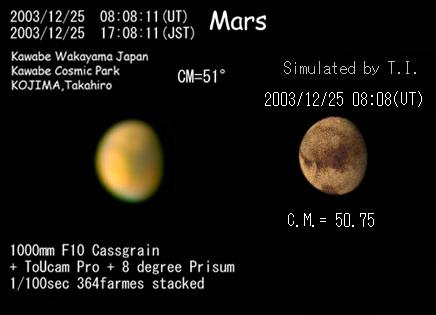
模様も黄雲も、眼視では認識できません。シーイングが
もう少し良ければいいんですが…。
≪和歌山県日高郡川辺町かわべ天文公園 小嶋孝弘≫
|
Ikuo Takimoto (310mm Newtonian :ToUcam Pro )
|
|

2003/12/25 11:18:41(UT)
C.M.=97.10
P=330.54
LS=322.24 Dia.=8.88"
De=-26.10
468 frames Stacked
Seeing:4/10 Trans:2/5
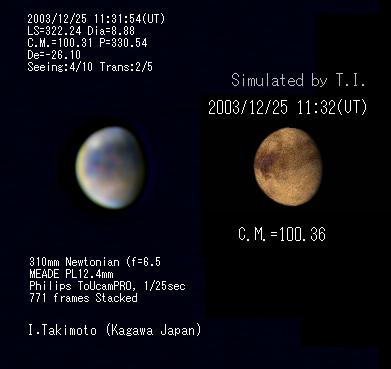
2003/12/25 11:31:54(UT)
C.M.=100.31
P=330.54
LS=322.24 Dia.=8.88"
De=-26.10
771 frames Stacked
Seeing:4/10 Trans:2/5
コメント:太陽湖の南部に砂嵐が明るく写っているが、砂嵐は少し拡散したか?
南極付近一帯も色が違うが、砂嵐の中なのだろうか?
Although dust storm was brightly reflected to the southern part of the SOLIS LACUS
was a little dust storm spread?
Is it in dust storm although a color is different near [ whole ] the South Pole?
[Ayauta-gun Kagawa-Prefecture Japan]
≪香川県 綾歌郡 瀧本郁夫≫
|
Teruaki Kumamori (600mm Cassegrain , PHILIPS ToUcam Pro)
|
|

クリュセ地方の黄雲が広がってもいますが北半球が全体に明るくなっています。
どこが見えているのか分からなくなりそうです。
≪大阪府 堺市 熊森照明≫
|
林敏夫 Toshio Hayashi (355mm Schumidt-Cassegrain, Philips ToUcam Pro )
|
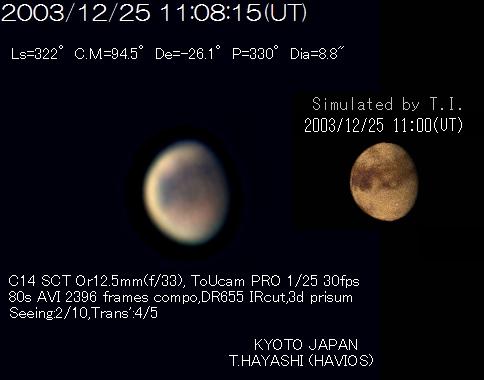
帰宅すると20時を回っているので、とっくに南中を過ぎ
西に傾いている。丁度この場所は風呂屋の煙突がある。
火星像が上空の気流と地上の熱気とでピントが余計に難しい。
何処が見えているか判らないくらいだが、中央に太陽湖がある
ようです。
何枚かの画像を処理して判断するのが正解なのでしょう。1枚だけの
処理画像だけで見ていると、太陽湖の下(北半球)に黄雲の卵が有る
のかと思う画像処理がされてしまう。何もないようである。
≪京都府京都市 林敏夫≫
|
|
Kwok-chuen Pau(350mm SCT ToUcam Pro)
|

Hi
I haven't make observation for a long time
this mars image was captured in the Christmas day
is it a dust cloud over the Solis Lacus?
Thanks.
[Canon Lau Hong Kong, China]
|
|
Donald C Parker(16-in (41cm) Newtonian)
|
Some dust clouds remain in eastern Hellas, Ausonia and southern Tyrrhenum.
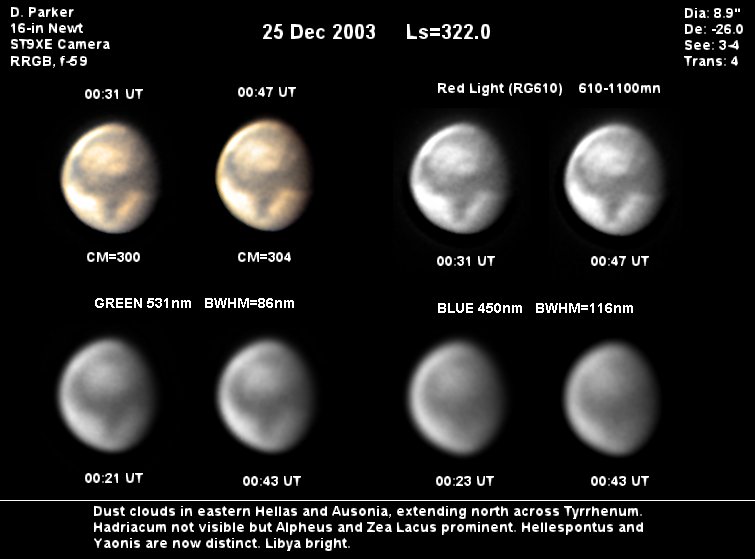 D.C. Parker, Coral Gables, FL. 16-in (41cm) Newtonian
ST9XE CCD Camera Eyepiece Projection @ f/59
Integration Times: RRGB Images
RED (RG610 Red Filter, 610-1100nm: NO IR Rejection) 0.18s 43 images
GREEN (CFW8C, 531nm central; BWHM 86nm) 0.70s 2-4 images
BLUE (CFW8C, 450nm central, BWHM 116nm) 2.80s 4 images
Images bias,flat and dark corrected.
Seeing poor, (3-4 Pickering); pre cold front . Transparency = 4m .
Wind SW-W 2-7 kts. Altitude = 62-59 degrees. Moderate dew.
Dust clouds in eastern Hellas and Ausonia, extending north across Tyrrhenum.
Hadriacum not visible but Alpheus and Zea Lacus prominent. Hellespontus and
Yaonis are now distinct. Libya bright.
[ Donald C Parker Coral Gables, Florida U.S.A]
D.C. Parker, Coral Gables, FL. 16-in (41cm) Newtonian
ST9XE CCD Camera Eyepiece Projection @ f/59
Integration Times: RRGB Images
RED (RG610 Red Filter, 610-1100nm: NO IR Rejection) 0.18s 43 images
GREEN (CFW8C, 531nm central; BWHM 86nm) 0.70s 2-4 images
BLUE (CFW8C, 450nm central, BWHM 116nm) 2.80s 4 images
Images bias,flat and dark corrected.
Seeing poor, (3-4 Pickering); pre cold front . Transparency = 4m .
Wind SW-W 2-7 kts. Altitude = 62-59 degrees. Moderate dew.
Dust clouds in eastern Hellas and Ausonia, extending north across Tyrrhenum.
Hadriacum not visible but Alpheus and Zea Lacus prominent. Hellespontus and
Yaonis are now distinct. Libya bright.
[ Donald C Parker Coral Gables, Florida U.S.A]
|
|
Mars Global Surveyor (Mars Orbiter Camera)
|
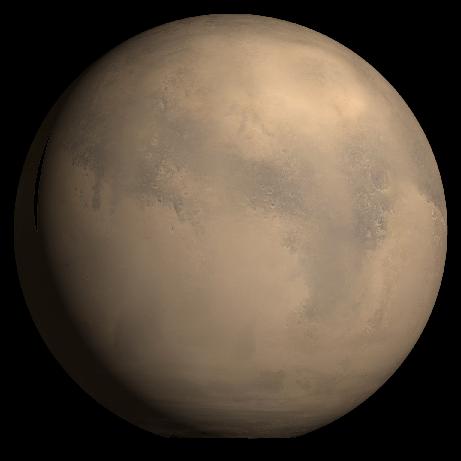
Large size jpg 97kb 1536X1536
This is how Mars appeared to the Mars Global Surveyor (MGS) Mars Orbiter Camera (MOC) wide angle system
on 25 December 2003, the day that Beagle 2 and Mars Express reached the red planet. The large, dark
region just left of center is Syrtis Major, a persistent low albedo terrain known to astronomers for
nearly four centuries before the first spacecraft went to Mars. Immediately to the right (east) of
Syrtis Major is the somewhat circular plain, Isidis Planitia. Beagle 2 arrived in Isidis Planitia
only about 18 minutes before Mars Global Surveyor flew over the region and acquired a portion of this
global view. Relative to other global images of Mars acquired by MGS over the past several martian years,
the surface features were not as sharp and distinct on 25 December 2003 because of considerable haze
kicked up by large dust storms in the western and southern hemispheres during th previous two weeks.
The picture is a composite of several MGS MOC red and blue daily global images that have been
map-projected and digitally wrapped to a sphere. Although the effect here is minor, inspection of
this mosaic shows zones that appear smudged or blurry. The high dust opacity on 25 December impacted
MOC's oblique viewing geometry toward the edges of each orbit's daily global mapping image,
thus emphasizing the "blurry" zones between images acquired on successive orbits.
Image Credit:
NASA/JPL/Malin Space Science Systems
Image Note:
2004.01.08.25Dec03global
≪NASA/JPL/Malin Space Science Systems≫
 ALPO-Japan Latest ALPO-Japan Latest

 Mars Section Mars Section
|
 FROM Makoto ADACHI
-------------------------------------------------------------------------------------
FROM Makoto ADACHI
-------------------------------------------------------------------------------------
FROM Makoto ADACHI -------------------------------------------------------------------------------------







D.C. Parker, Coral Gables, FL. 16-in (41cm) Newtonian ST9XE CCD Camera Eyepiece Projection @ f/59 Integration Times: RRGB Images RED (RG610 Red Filter, 610-1100nm: NO IR Rejection) 0.18s 43 images GREEN (CFW8C, 531nm central; BWHM 86nm) 0.70s 2-4 images BLUE (CFW8C, 450nm central, BWHM 116nm) 2.80s 4 images Images bias,flat and dark corrected. Seeing poor, (3-4 Pickering); pre cold front . Transparency = 4m . Wind SW-W 2-7 kts. Altitude = 62-59 degrees. Moderate dew. Dust clouds in eastern Hellas and Ausonia, extending north across Tyrrhenum. Hadriacum not visible but Alpheus and Zea Lacus prominent. Hellespontus and Yaonis are now distinct. Libya bright. [ Donald C Parker Coral Gables, Florida U.S.A]

 ALPO-Japan Latest
ALPO-Japan Latest

 Mars Section
Mars Section